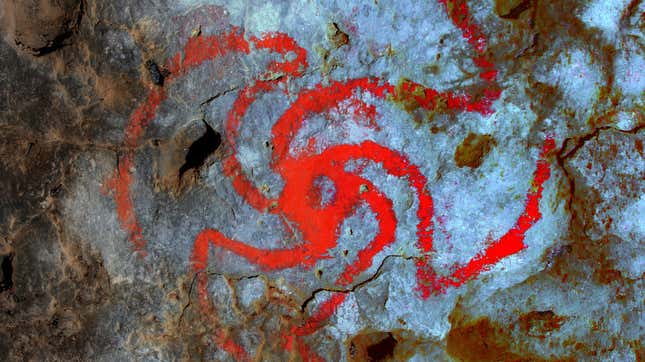
There’s a cave in California, roughly an hour’s drive from Santa Barbara, whose ceiling features a prominent pinwheel-like drawing. Fascinating new research suggests this painting is not some drug-induced abstraction, but a literal representation of the very thing that makes psychedelic trips possible.
Chewed remnants of the psychedelic plant Datura wrightii offer “unambiguous confirmation of the ingestion of hallucinogens” at Pinwheel Cave in California, according to new research published in Proceedings of the National Academy of Sciences. The rock site was frequented by indigenous Californians roughly 500 years ago. Just as importantly, the dazzling red pinwheel painted onto the low ceiling is a representation of the plant itself, not a depiction of a shaman’s visual experiences while tripping on the drug, the scientists argue. The new paper is consequently challenging the prevailing altered states of consciousness model (ASC), which contends that “hallucinogens have influenced the prehistoric making of images in caves and rock shelters,” as the study authors write.
Indeed, it might be time to retire this seemingly outdated notion. The ASC model suggests abstract images found in cave paintings across the world—things like swirls, zigzags, dots, geometric shapes, and possibly even therianthropes (part-human, part-animal beings)—were inspired by psychedelics. Some experts have even argued that these abstract images are self portraits made by shamans, or depictions of shamans’ experiences while in a trance. That regular folks might partake in these drugs is rarely considered by anthropologists and archaeologists—and in fact, it’s often argued that these cave sites were exclusive to shamans, not a space for the rest of the group.

Trouble is, evidence to support the ASC hypothesis is sorely lacking, as the new paper, led by David W. Robinson from the University of Central Lancashire, points out. Instead, these ambiguous shapes are likely “stock iconographic images drawing upon mythology and the personifying of insects, animals, plant, and astronomical elements such as the sun,” according to the paper.

But in this case, the drawing in question isn’t even ambiguous—the pinwheel painting really does look like the Datura plant, the flowers of which uncoil to reveal a five-pointed, pinwheel-like configuration. Moreover, ethnographic accounts describe how indigenous Californians consumed these plants as a means to enter into a trance state. Datura could be ingested for a variety of reasons, including “to gain supernatural power for doctoring, to counteract negative supernatural events, to ward off ghosts, and to see the future or find lost objects, but, most especially, as a mendicant for a variety of ailments,” as the authors write. Datura was prepared in any number of ways, including as a drink, but the simplest was to chew on the roots or other parts of the plant.
Robinson and his colleagues have been exploring Pinwheel Cave since 2007. Of significance, the team found quids stuffed into cracks along the cave’s ceiling. These fibrous bundles of plant material are often found buried at archaeological sites, with quids typically consisting of yucca, agave, tule, and tobacco, which prehistoric people chewed to obtain nutrients or stimulants.
DNA analysis of the quids found in Pinwheel Cave failed to identify the source plant, so the scientists turned to other techniques. A scanning electron microscope confirmed the items as quids, as the discarded wads showed evidence of chewing. A mass spectrometer detected the active psychedelic ingredients in Datura, namely scopolamine and atropine.
“This indicates that Datura was ingested in the cave and that the rock painting represents the plant itself, serving to codify communal rituals involving this powerful entheogen [hallucinogen],” the researchers write. “These results confirm the use of hallucinogens at a rock art site while calling into question previous assumptions concerning trance and rock art imagery.”
Paul Bahn, author of The First Artists: In Search of the World’s Oldest Art, said that the discovery of Datura compounds in the quids was “a nice piece of archaeological analysis,” but he was highly skeptical of the certainty with which they identified the painting as representing the flower itself. “Only the artist can tell us what the drawing represented, if anything. They are interpreting it, not identifying it. Now, there is a possibility that it depicts what they want it to depict, but we have absolutely no way of knowing, and there are many other possibilities.”
Fair point, but the suggestion that the pinwheel represents Datura is hardly a stretch, as the plant was likely a very big deal for this community. A depiction of Datura on the cave ceiling allowed the community to visually express its social, cultural, and metaphysical significance.
And indeed, Pinwheel Cave was a shared space, as other archaeological evidence reveals. In addition to the quids, the researchers found evidence of stone tool manufacture, projectile points, and signs of cooking, such as burnt bones and charcoal. So a space exclusive to shamans? No way.
Despite Bahn’s reservations about the interpretation of the image, he’s happy to see the shift away from the ASC model.
“[One] major plus of this paper is that they have broken away from the ludicrous school of thought that dominated for a while in the 1990s and early 2000s, which saw all rock art as trance imagery produced by shamans, and which did tremendous damage to rock art studies all over the world, and notably in the USA,” said Bahn. “To that extent, it is a breath of fresh air.”
Archaeology is tough, and it takes time—and tons of evidence—to reach the truth, or at least something approximating the truth. The new research nicely chips away at an old theory that probably used to make a lot of sense, but on further review, seems a bit old fashioned, if not completely silly.
This post was updated to include the comments made by Paul Bahn.